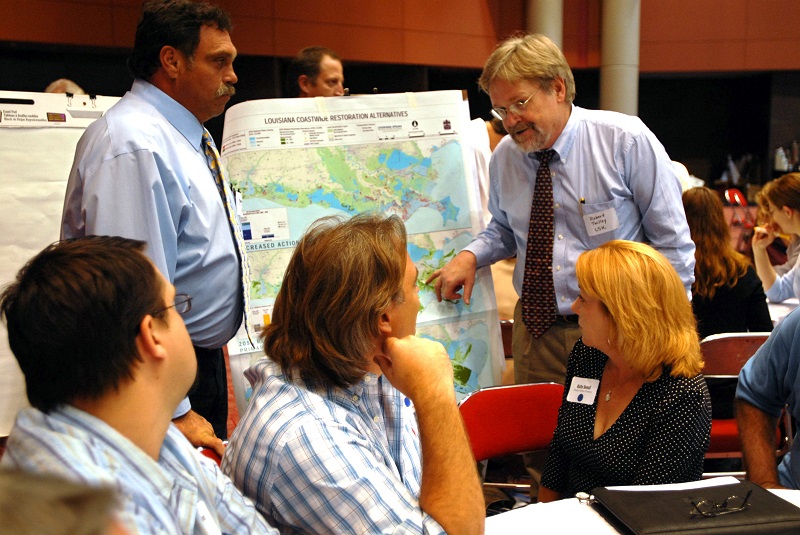Supporting the Science and Technology of Louisiana’s Coastal Master Plan
January 12, 2022
Excerpt from From Air to Land to Sea: 50 Years of Educating Coastal Leaders (publication forthcoming)
By Robert Twilley

Robert Twilley leading one of the many workshops across the coast in 2006 following Hurricanes Katrina and Rita.
– Robert Twilley
The State of Louisiana under the leadership of the Coastal Wetlands Planning, Preservation, and Restoration Act (CWPPRA) collaborated to develop Coast 2050, a strategic plan for creating an enduring and sustainable Louisiana coast. Approved in 1998, this consensus-based, stakeholder-informed initiative generated a plan that relies on a variety of restoration tools – from shoreline protection and marsh creation to the reintroduction of fresh water and sediment to deteriorating wetlands. Coast 2050 also set the goals higher to develop a comprehensive planning effort as a joint chief engineers report between Louisiana and U.S. Army Corps of Engineers entitled “The Louisiana Coastal Area Ecosystem Restoration Study.” The challenge was to develop the science and technology necessary to design specific projects out of the restoration concepts and strategies outlined in Coast 2050.
Higher education was asked to respond to this challenge by providing science and engineering expertise and working with state and federal agencies on developing credible projects that would meet the goals of Coast 2050. LSU and other universities responded to the challenge, relying on the research and technological capacity in the LSU College of the Coast & Environment (CC&E). CC&E participated in the original LCA Framework Development Team (Dr. Joe Suhayda) and later housed the Coastal Louisiana Ecosystem Assessment and Restoration program, or CLEAR (Dr. Robert Twilley, PI). As the primary agent in a vital partnership between the Louisiana university system and state resource management agencies, the CLEAR Program expanded the capacity of these partners to address issues of primary importance to Louisiana and the nation. CLEAR provided the State of Louisiana, through contracts with Louisiana Department of Natural Resources (LADNR), with a powerful planning mechanism to apply toward the goals of restoring and maintaining both natural and economic resources in the coastal zone. The results of the LCA study, which were finalized and published in 2004, identify 15 projects categorized as “critical near-term features.”
Following the hurricanes of 2005, the state called on the CLEAR Program to provide information critical for the development of long-range coastal protection and restoration plans. These activities demonstrated the program’s value to executive levels of government, the governor, and the legislature, and its potential utility in pursuing a broader set of goals. CC&E had contracts with both LADNR and Baton Rouge Area Foundation to utilize CLEAR and partner universities to develop the 2007 Coastal Master Plan and the 2007 Louisiana Speaks regional plan. These two historical documents provided comprehensive planning strategies for both the natural, economic, and cultural resources of coastal Louisiana. This leadership by CC&E and faculty at LSU, among others in the state, employed quality information in planning and decision-making through reporting on objective measures of project performance. The CLEAR Program served as an umbrella for environmental science applied to coastal protection and restoration in Louisiana, synthesizing existing information and communicating a model for how the natural processes interact with human activities. CC&E housed the first LCA Science & Technology Office and continued to provide critical leadership and workforce development during the formation of the Coastal Protection and Restoration Authority and other regional planning efforts. From these efforts in planning for the future, CC&E— under direction of Robert Twilley—founded the Coastal Sustainability Studio that today provides ecosystem design approaches that integrate across disciplines in linking social, environmental, and technological systems in coastal Louisiana.
References:
Louisiana Coastal Protection and Restoration Authority. 2007. Louisiana’s Comprehensive Master Plan for a Sustainable Coast.
Steyer, G.D., A.B. Owens, and B.R. Couvillion. 2006. Data Collection Network to Support Ecosystem Forecasting for the Barataria Basin – Mississippi River Domain. In Coastal Environment and Water Quality (ed. by Y. J. Xu & V. P. Singh), 431-442. Water Resources Publications, LLC, Highlands Ranch, CO 80163-0026, USA.
U.S. Army Corps of Engineers, New Orleans District. 2004. Louisiana Coastal Area (LCA), Louisiana Ecosystem Restoration Study. Appendix C: Hydrodynamic and Ecological Modeling.